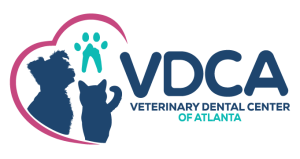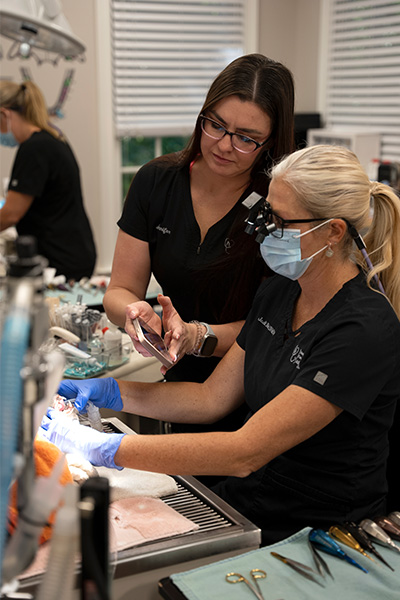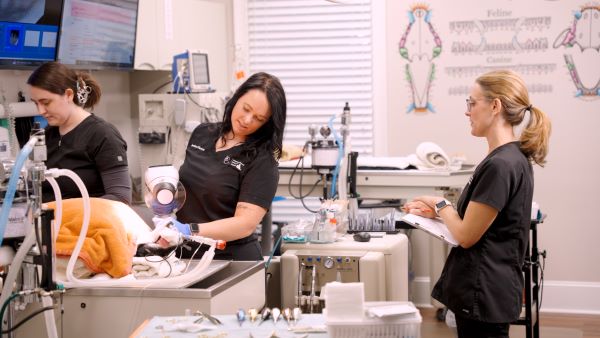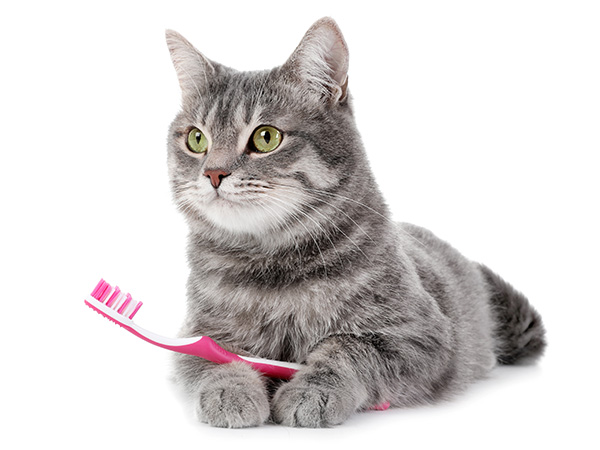Complete Oral Health and Treatment
(COHAT)
Even with the most dedicated home dental care routines for your pet, it’s essential to incorporate comprehensive oral health assessments and treatments (COHATs), often referred to as cleanings, into their regular dental care. Pets, like humans, accumulate plaque—a bacterial film that quickly forms on teeth within a few hours after brushing. Plaque tends to accumulate under the gum line and within the nooks of the teeth, so daily tooth brushing and flossing, especially for pets with close-set teeth, are recommended.
We recognize that daily dental care can be challenging for pet owners, particularly those with cats. While flossing might not be feasible for every pet, this highlights the importance of regular veterinary dental care to maintain your pet’s oral and overall health.
Challenges Posed by Plaque
Over time, plaque traps and combines with saliva, food particles, and bacteria, transforming into tartar or dental calculus. This tartar firmly adheres to the teeth and is difficult to remove through brushing alone, necessitating a COHAT for thorough removal, particularly from beneath the gum line and among tightly packed teeth. If tartar persists, it leads to gingivitis, which fortunately can be reversed with consistent home care and professional cleanings.
Dental Disease Prevention
Dental disease is common in dogs and cats but is largely preventable with routine dental care. If plaque is not regularly removed, it hardens into tartar, which harbors bacteria that cause gingivitis and can eventually lead to infection, periodontal disease, and tooth loss. If dental disease is left untreated, bacteria can spread from the gums into the bloodstream, potentially harming the heart, liver, and kidneys.
Preventive care, including consistent home dental maintenance, regular veterinary examinations, and professional cleanings as recommended, is the optimal approach to managing dental disease.
Various dental care products are available for pets, such as toothpaste and toothbrushes designed for pets, dental chews, mouthwashes, dental sealants, water supplements, and dental diets.
Periodontal Disease
If gingivitis is left unchecked, it progresses to periodontal disease, damaging the soft tissue and bone that support the teeth. This condition worsens as the gums become inflamed and recede, forming pockets that trap more debris and bacteria. This can irreversibly damage the bone and tissue without timely treatment, leading to tooth loss.
Overall Health Implications
Pets with untreated periodontal disease often suffer from chronic pain and infections and have an elevated risk of developing complications in their heart, kidneys, and lungs, particularly as pets age. Regular COHATs are crucial for maintaining your pet’s health and are not prohibitively expensive.
Anesthesia Benefits and Risks
Older pets also benefit from regular COHATs under anesthesia, with a clear discussion of anesthesia risks versus benefits. It’s a misconception that older pets cannot safely undergo anesthesia. At VDCA, we emphasize the importance of dental care for senior pets and have seen significant improvements in their longevity and quality of life with proper dental management.
Routine Oral Examinations
During a typical veterinary visit, a basic oral exam can be conducted, depending on how cooperative your pet is. This examination, which involves inspecting the teeth and gums, can reveal conditions such as gingivitis and tartar accumulation and help decide whether a COHAT is necessary.
More thorough oral exams require anesthesia to avoid missing any underlying problems. Pets need to be completely still due to the use of sharp instruments and the positioning of their jaws in a wide open position to assess the teeth in the back of their mouth.
Oral Exams Under Anesthesia
Anesthesia allows for a detailed examination of each tooth and the oral cavity, including digital radiography to investigate below the gum line. This includes using ultrasonic scalers and manual instruments to remove all plaque and tartar, followed by tooth polishing to prevent future plaque buildup.
An additional advantage of using anesthesia during a COHAT is the placement of an endotracheal tube, which delivers oxygen and inhaled anesthesia, safeguarding your pet’s airway. The cleaning process involves significant water usage, and as tartar is removed, bacteria are released. Without airway protection, there is a risk that water, bacteria, and tartar particles could be inhaled into the lungs, potentially causing pneumonia and severe respiratory infections.
Understanding Anesthesia Risks
Though anesthesia always presents risks, adverse effects are exceptionally rare. We take every precaution to ensure the safety of your pet. These include pre-anesthetic blood work, using the safest anesthetic agents, and thorough monitoring throughout the procedure to ensure a quick and safe recovery.
Complete Oral Health and Treatment (COHAT)
Steps for a Professional Dental Cleaning Under Anesthesia:
-
1. Initial Cleaning
The COHAT procedure begins with using an ultrasonic scaler and manual tools to thoroughly remove plaque and tartar from above and below the gum line, within the crevices of the tooth crown, and between the teeth. After the scaling, a disclosing solution is applied to confirm that all plaque and tartar have been effectively eliminated.
-
2. Polishing
The scaling process may leave fine scratches on the enamel, which can attract more plaque and expedite tartar formation. To address this, each tooth is polished using a low-speed handpiece and prophylactic paste, restoring the tooth enamel’s smooth, shiny finish.
-
3. Detailed Oral Exam
An exhaustive oral examination follows, assessing each tooth individually along with the gums, lips, tongue, palate, and throat. This exam includes probing to measure periodontal pockets and identifying dental abnormalities such as oral masses, loose or abscessed teeth, gingivitis, missing teeth, and more. All findings are meticulously recorded for ongoing monitoring.
-
4. Radiographs (X-rays)
A digital radiograph machine takes dental radiographs as needed. Ideally, a full-mouth X-ray is recommended during each dental procedure to visualize 60% of the tooth structure that lies beneath the gumline and is not visible otherwise. X-rays are particularly crucial if any anomalies are detected during the oral examination, including fractured, loose, missing, extra, malformed, misaligned teeth, resorptive lesions, cavities, deep periodontal pockets, oral masses, or swellings.
-
5. Application of Barrier Sealant
A temporary protective sealant, Oravet, is applied to all teeth, focusing on the base of the gumline to inhibit future plaque accumulation. This sealant remains effective for up to two weeks post-cleaning. It is recommended that this protective measure be continued weekly at home, and instructions for application will be provided during your pet’s complimentary post-dental follow-up visit two weeks after the procedure.



